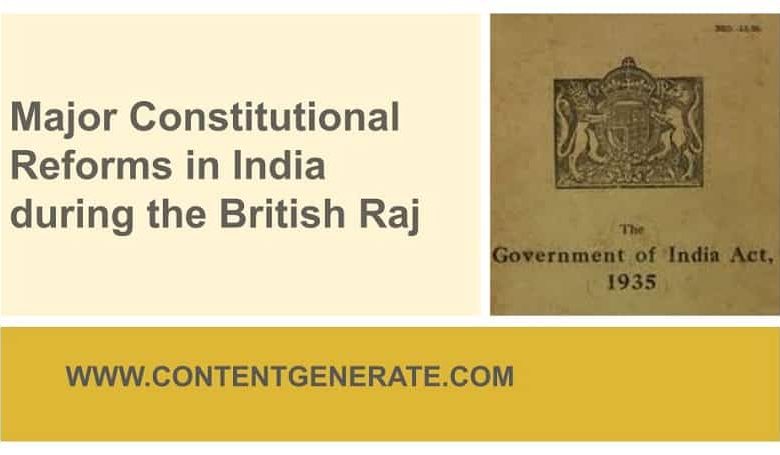Majors Acts and Events Contributing Towards the Constitutional Reforms in India

This post briefly but succinctly describes the major acts and events that contributed to the constitutional reforms in India during British Raj from 1909 to 1935.
Contents
Morley-Minto Reforms 1909
In 1909, the British parliament passed new reforms which acted as the constitution for India for the next decade. These reforms for the first time introduce the principle of election for the membership of the imperial and local councils.
We know these reforms as Minto-Morley Reforms as Lord Morley ( the secretary of state for India) and Lord Minto (the viceroy of India) had drafted them. But, officially these reforms are referred to as “the Indian Councils Act of 1909”.
Moreover, the act provided an increase in the number of council members including reforms in the power distribution.
What were the main features of Minot-Morley Reforms 1909?
The salient features of the Indian Councils Act (Minot-Morley Reforms) 1909 are as follows:
1. Contrary to the past, these reforms provided an increase in the membership of the Imperial and Central Executive Council.
2.The number of non-official members increased but their number was still fewer than official members directly appointed by the British.
3. The council did not enjoy the power to make decisions. Their role was only advisory; they could discuss important matters and give recommendations to the government.
4. The reforms also included an increase in the number of members of the provincial councils. The no. of members of the larger provinces was to be 50 whereas smaller provinces would have 30 members in their councils.
5. The demand of Simla Deputation, 1906 was accepted as the government provided separate electorates to Muslims in 19019.
Reversal of Partition of Bengal 1911
- King George V announced the Annulment of Bengal Partition a durbar in Delhi on his visit to India in December 1911.
- The reason for the decision of reversal of the partition was the fierce opposition of Bengali Hindus who had created a situation of chaos and law and order thus making it difficult for the British to rule Bengal.
- As Muslims were happy with the Partition, hence they opposed the British decision to reverse the partition.
- Since the partition of Bengal, the Muslims had been supporting the British as they promised to maintain the partition.
- In view of changing policies of the British in utter disregard of their promises, Muslims started to lose faith in the government.
- In short, with the reversal of the partition, the Muslims felt betrayed by the British.
Lucknow Pact, 1916
An outcome of the joint efforts of Mr. Muhammad Ali Jinnah and Mahajan
All India Muslim League and Indian National Congress were two major political platforms of India. Differences between them did more harm to India than any good. Thus reconciliation between these two important parties was need of the hour in order to get increased powers.
For the purpose of creating rapprochement between the league and the Congress, two young politicians Mr. Jinnah and Mahajan a congress leader came forward. They were successful in their efforts as both league and the Congress held a joint session at Lucknow in 1916.
Furthermore, the participating parties concluded a Pact in this session called Lucknow Pact 1916. This pact manifested unprecedented cooperation and goodwill for each other and a pledge to work together against the British. In other words, both the Congress and the league agreed to shun their differences, accommodate each other and launch a joint struggle for the independence of the Indian subcontinent.
The credit to bring Congress and the league goes to Mr. Muhammad Ali Jinnah who worked hard within Congress and League to bring them on one page.
Main features of Lucknow pact, 1916
Congress agreed to:
- Right of separate electorates for representation of Muslims in the councils.
- One-third representation in the councils at the center.
- Passage of any act related to any community only in case of support of three-quarters of the respective community.
- All Indian Muslim League agreed to:
- Support congress in her demand for self-government in India.
- The pact demanded the British to:
- Increase the elected seats on of the councils
- Accept any motions or resolutions by majorities in councils as acts.
- Provide security to minorities in provinces.
- Provide equal autonomy to all provinces.
Simon Commission 1927
The British government set up a statutory commission to draw proposals for future constitutional reforms in India. Today, we call this commission the Simon Commissionb1927. At that time it was the conservative government that sent the commission to India in 1927 to see and suggest proposals for future reforms in India.
1. The Commission consisted of seven members, all were British.
2. The government appointed a British Judge, Sir John Simon as the chairman of the commission.
3. Consider the situation of India and suggest proposals for future reforms in India.
4. The formation and arrival of the commission received opposition from political powers in India. The local political parties protested and did not cooperate with the commission.
5. The commission completed its tour and gave the following proposals in its report 1930 for future reforms in India:
- Abolition of diarchy and introduction of representative government in the provinces.
- Continuation of Separate Electorates only until communal tension eases down.
- Proposal of round table conferences to consider local views about future constitution-making.
Nehru Report 1928
Nehru Report was a result of the Nehru Committee which held a conference to deliberate and make a draft of the constitution in response to the Indian viceroy’s challenge that Indians are not capable of recommending legal reform.
Nehru Committee consisted of members of local political parties i.e. Congress, the league, Hindu Mahasabha, Sikh Central League, National Liberal Foundation, etc.
The Nehru committee drafted and published its report (Nehru Report) of the proposals in 1928.
Main features of Nehru Report
The Nehru Report 1928 contained the following salient features:
- The British should declare India an independent state with dominion status.
- India would be a federation with two-house parliament.
- Elections for the councils Universal take place on basis of universal suffrage both at the center and provinces.
- The committee demanded Separate electorates for Muslims.
- The future constitution should ensure the protection of minorities through the introduction of another mechanism.
- Indian would be a secular state with guarantees has equal rights for women and men.
- Hindi would be the official language.
Jinnah’s 14 points 1929
Like that of other political parties of India, the league also attended the meetings called by the Nehru committee concerning future constitutional reforms. Mr. Jinnah represented the All-Indian Muslim League in the Nehru Committee.
Jinnah opposed the anti-Muslim proposals concerning a future constitution of India. Instead of giving serious attention to its views, the committee members made fun of Jinnah as if his views did not carry any weight. Mr. Jinnah boycotted the Nehru committee’s meetings and when the committee published its report, he called it parting ways with the Congress.
Jinnah presented 14 important proposals for the future constitution of India as a substitute for the Nehru Report. We call these 14 proposals as Fourteen Points of Jinnah.
The following is the list of the Fourteen points of Mr. Jinnah:
1. The future constitution of India should be federal in nature with strong provinces.
2. All provinces, small or big, should enjoy equal and same autonomy.
3. The central and provincial assemblies have adequate representation of minorities.
4. Muslims should have one-third representation in the assemblies.
5. Government should hold future elections for the councils on basis of separate electorates.
6. Any future territorial changes that the government may bring about in the future should not affect Muslim majority status in NWFP, Punjab, and Bengal.
7. All communities should enjoy complete liberty of faith and worship.
8. The assemblies would not pass any act if three fourth of any community members in the council opposed it.
9. Sindh should be separated from the Bombay Presidency.
10. The government should introduce reforms in NWFP and Balochistan to bring them to par with other provinces.
11. The government should provide a quota for government jobs.
12. The constitution should provide guarantees for the protection of Muslim culture, education, language, religion, and charities.
13. Muslims should enjoy one-third representation both in the central and provincial cabinets.
14. There should not be any change/s in the laws without taking the consent from provinces.
Round Table Conferences 1930-32
The importance of the Round Table Conferences held in London cannot be belittled. Because these conferences as important political events have led to improvement in the future constitutional reforms in India.
Where did the idea of the round table conferences come from?
The Simon Commission completed its work by the year1930. After its meetings with the local politicians and public, the commission prepared a draft of proposals and reported to the Government. One of the proposals in the report was the calling for a Round Table Conference of Indian political leadership of all parties in Britain.
The British Government invited local political, social, and religious leaders accordingly to attend the Roundtable conference.
Following is a brief description of each conference.
1st Round Table Conference 1930
- The British government held the first Round Table Conference in London in November 1930.
- The political parties attending the conference included the league, the Congress, the liberals, and the princes.
- Moreover, the largest political party of India the Indian National Congress boycotted the conference thus making the developments made in this conference less effective.
- The princes conditionally accepted to join a future federation of India if the British guaranteed them their internal autonomy.
- last but not the least, the British agreed to introduce a representative government in provinces.
The Second Round Table Conference
- The Second Round Table Conference took place in London in September and December 1931 according to the announced schedule.
- Unlike the First conference, all of the Indian political parties attended the conference i.e. the Indian National Congress, the All India Muslim League, the National Liberal Foundation, and members of the Sikh Central League.
- Consequently, the Conference failed because Gandhi adopted a hard stance concerning minority problems.
3rd round Table Conference 1932
The third Round table was supposed to be held in November 1932 but it could not take place according to the scheduled date and timing. Like that of the first conference, Congress boycotted the third conference. Similarly, the princely states also boycotted the conference. Hence, the Conference failed as none of the parties attended.
Secondly, the lack of interest on behalf of the new conservative party in giving more power to locals was also a reason.
The Government of India Act 1935
The Government of India Act 1935 was the last of the major constitutional reforms in India, introduced by the British before their departure.
What were the main features of the Government of India Act 1935?
According to this act:
1. India would be a federation consisting of both British India as well as the princely states
2. There would be a bicameral legislature with 156 and 250 members in the Upper and lower house respectively.
3. The members from British India would become council members through elections whereas the members from princely would come through nomination.
4. Unlike the Government of India Act 1919, the system of diarchy would cease to exist in provinces. It would be introduced in the center.
5. Like those of the earlier reforms, the Governor-General would again act as the head of the federation with special powers in the reserved subjects.
6. According to the promise that they made in the second round table conference, the British finally introduced a representative government in provinces with a degree of autonomy.
7. The British finally granted the status of full-fledged provinces to Sindh, NWFP, and Orissa. As a result, the total number of provinces increased to 11.
8. In contrast to the local expectations, the new reforms provided a limited franchise. Only 25% of the population could vote in the elections at the provincial level.
What was the reaction of local political Parties to the Government of India Act 1935?
The locals expected that the British would transfer more and more powers to locals in its new reforms. On the contrary, the new reforms offered a system controlled by the British except for the changes it had introduced in provinces. As a result, the two major political parties of India, the league and the congress strongly rejected the new reforms.
According to Gandhi, the new act was a charter of slavery. As far as Mr. Jinnah was concerned, he also rejected in the same way Gandhi did. Jinnah also condemned the reforms and called them thoroughly rotten, fundamentally bad, and totally unacceptable.
Conclusion
Thus, the introduction of new constitutional reforms in India had been a controversial issue not only between the British and locals but also between the locals themselves. Nevertheless, the British, the Congress, and the league did not lose hope to find a better solution concerning future constitutional reforms in India.


